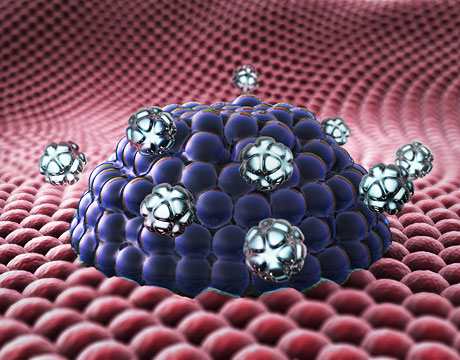Nanoparticles Kill Cancer
Nanoparticles Kill Cancer


Of the more than 200 types of cancer that threaten the human organism, lung cancer is the deadliest. It’s responsible for some 27 percent of all cancer deaths, and less than 20 percent of those diagnosed with the disease will beat it. The attempt to do so usually involves chemotherapy, radiation, or lobectomy, all of which come with difficult side effects. Now there’s some hope that the nearly half-million people with lung cancer could some day be treated with an inhaler and a few magnets.
The key to the possible treatment is the superparamagnetic iron oxide nanoparticle. Jayanth Panyam, a professor in the Department of Pharmaceutics at the University of Minnesota, has shown in lab work with rats and mice how the method would work. Patients would first suck the nanoparticles into their lungs. Then, they would be surrounded by an oscillating magnetic field, which would heat up the particles. “If you can localize these particles in or next to the tumor cells then you can heat the tumor cells and then they die,” he says. Panyam proved the effectiveness of the technique by injecting nanoparticles into tumors in mice. When he subsequently put the mice inside of a small magnetic coil and turned on the juice, he successfully killed tumor cells.
To get the particles to where they need to be, and away from healthy cells, the nanoparticles would likely be attached to peptides that would attach onto tumors. “Then you would have a more selective tumor cell kill,” says Panyam. The heat given off by the particles dissipates within mere microns, so nearby healthy cells will, for the most part, remain unscathed. “The hope is that, yes, you may have some nonspecific distribution to the healthy cells, but if the concentrations are not high enough you wouldn’t induce enough heat to kill the cells,” he says.
As of now, the technique attacks only the surface of a tumor. Panyam’s lab is working on creating a protein cocktail that would help the particles “shoot through the tumor matrix.” But however deep such nano drills might penetrate, they’re not likely to extinguish a tumor entirely on their own. “This would probably not be a stand-alone treatment,” says Panyam.
Panyam’s most recent paper shows that the way the cells die depends on the size of the particles. Researchers had thought the magnetically heated particles killed cells by inducing hyperthermia, “a slow form of death,” he says. But Panyam found that larger aggregates of nanoparticles were killing tumor cells in an entirely different manner. The oscillating magnetic field was causing the particles to actually move. The heat coming from the particles wasn’t what was killing the cells. Instead, the particles were literally ripping open the cell membrane. “These micron-sized aggregates actually induce necrosis, the more violent form of death,” says Panyam.
The finding was so surprising that Panyam and his colleagues thought perhaps the larger particles were heating up more and perhaps burning a hole through cell membranes. But when they put the particles and cells in a cool bath, they found that when hit with the magnetic field, they killed the cells in the same way.
“In cancer that might actually be more beneficial. Necrosis can stimulate an immune response, and that is more effective in eliminating tumor growth,” says Panyam.
Whatever the size of the particles and how they do their killing, the technique might not be limited to inhalation and lung cancer. “When the surgeon goes in and cuts out the tumor, you could introduce the particles right on the site of the tumor,” Panyam says. With the right proteins, and afew more studies, it may someday be the smallest particles that take down one of the biggest killers.
Michael Abrams is an independent writer.
Learn more at ASME 2015 4th Global Congress on NanoEngineering for Medicine and Biology
If you can localize these particles in or next to the tumor cells then you can heat the tumor cells and then they die.Prof. Jayanth Panyam, University of Minnesota





